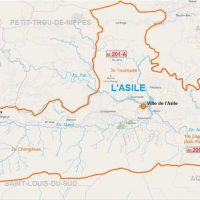L’asile

The city of L’Asile was built at the border of a traitorous jungle and is truly an ancient phenomenon. Its elegance is matched by the backdrop of an abundance of hills which have helped shape the city to what it is today. The climate these hills brought were of great importance, but they were also influential when it came to architectural designs as the vast majority of buildings have been built with elements of the hills around them.
L’Asile, a tiny, isolated village off Route Nationale 2, Anse-à-Veau Arrondissement, is an inland destination with overflowing rivers. It’s marked by unpainted buildings, many surrounded by high land.
L’Asile is also a locality about 118miles (190 km) southwest from Port-au-Prince, in the Haiti department of Nippes. Together with the localities of Tournade, Changeux and Morriseau, it constitutes the Commune of L’Asile, which is consolidated. As of the 2015 census, the population was 41,000.
L’Asile became an independent municipality, formed by the splitting from of the commune of Anse-à-Veau. Raised to the rank of commune in 1934, it is an interior (inland) town.
The name “L’Asile” is adapted from the French language meaning “asylum”. An asylum is a place of refuge where one finds safety and protection
According to the U.S. Census Bureau, the commune has a total area of 59 square miles (154 km2).
L’Asile has hilly terrain and its climate varies according to the season and according to the place where one is in the commune. Its inhabitants bear the name of Asilois. In 1998, the population of the municipality of L’Asile was estimated at 41,641 inhabitants, the majority, being 98% living in rural areas. In 2003, it has reached 30,000.
Economy: The residents of L’Asile experience back-breaking poverty, earning only $300 USD each year. They derive their income from farming produce on small tracts of land. Bringing their crops to market provides them with enough money to keep them from starvation.
Regarding the economic and financial infrastructure, the municipality is virtually devoid of it and in terms of economic activities, agriculture and livestock are predominant. Apart from the ten small shops located in the city of L’Asile (VAL), the town is almost completely devoid of commercial establishments; there is only one photocopy service and one hairdresser.
Infrastructure: L’Asile is surrounded by hills and many families make do with thatched-roof dwellings. For those who are able to afford the material, they build tin-roofed abodes. But whatever kind of housing they reside in, the population does not have either running water, or a dependable source of electricity.
Roads: Not surprisingly, L’Asile’s road infrastructure is nearly non-existent, and the few roads available that have been built are unpaved. Automobiles are also scarce in this primitive place.
Education: The Ministry of National Education of Youth and Sports has been represented in the commune for over forty-four years. Two people are currently staffing the office. From kindergarten to the end of secondary school year, there are schools for these grades in the town. After the private schools, there are public schools, there are communal schools and the “Lise Gwoman Lazil” (The Gwoman High School of Lazil). Many children in Lazil walk more than four kilometers to come to school; despite of this great sacrifice, we learn that there are about half of the children who stay home, either for economic reason or because of responsibilities that fall on their shoulders at home such as, taking care of livestock, going to the farms or busy with market activities.
Healthcare: The Ministry of Public Health and Population is not represented in the commune. L’Asile does have a main hospital, but it is under-equipped and dependent on aid relief for such necessities as antibiotics, sterilization, and intravenous drip supplies. This clinic is responsible to take care of the whole commune, including some other people who sometimes come from more than 6 kilometers away to come to the clinic for health care. The result has strained the hospital’s limited capabilities, but the medical facility has managed to remain open.
When nothing can be done for a sick person, they send that person to either Bònfen (Bonne fin) or Fondènèg (Fonds-des-Nègres).
Two dispensaries were also located in the commune. The health service is provided in the area by one doctor, one nurse, three auxiliaries and a laboratory technician.
Utilities: In terms of technical infrastructure, the community of L’Asile has three rivers and seven sources. For electricity and communication, only the city (VLA) is electrified by an electric motor under the direction of the town hall.
Religion: On the side of religion, many faiths were counted in the commune. The number of churches (chapels included) appears to be more numerous for Catholics, Baptists and Pentecostals.
More than three-quarters of L’Asile’s residents practice Catholicism with the remaining 25% either Protestant or Vodun adherents. The Roman Catholic Church of St. Joseph’s overlooks the village.
Leisure: As for Leisure, the town has no library, no museum, and movie theater. Football (soccer) is played on one field in the city of L’Asile, and twenty-one gauntlets run daily in the town. In terms of cultural heritage, the town has no monuments and sites, there is only one place of pilgrimage which is located in the first communal section.
Communication: The telephone service is provided by four employees. Thirty-four lines are available, but only three of them operate as a booth at the Teleco office itself. There is only one factor where people go to pick up their mail. Apart from a radio station located in the city for about two years the town of L’Asile does not have a television station or newspaper / magazine.

